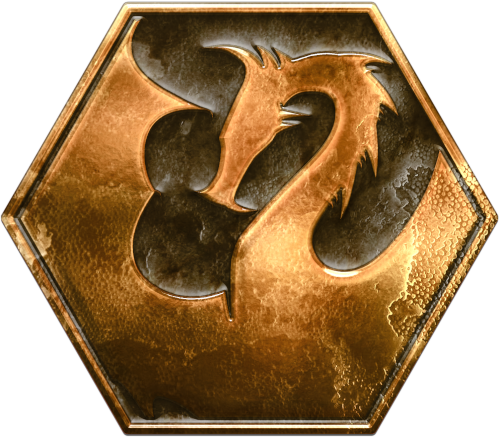In Level Up, Species is broken up into Heritage (who your parents were) and Culture (the society you grew up in).
Dragonborn Heritage

a5e.tools
The dragonborn were created by ancient dragons as servants, soldiers, and perhaps even as cherished children. Dragonborn are humanoid creatures instilled with the power and adorned with the scales of their draconic progenitors. Countless ancient wyrms have sired dragonborn clans, and no two are alike. The dragonborn banner flies over the ferocity of the chromatic dragonborn, the noble cunning of the metallic dragonborn, the mystery of the gem dragonborn, and even the ancient wisdom of the essence dragonborn.
Scales, tails, horns, fangs, claws, wings, and any feature found within dragonkind may emerge randomly for a generation, only to fall back into remission for the next. Despite this, some draconic features remain constant. Whether it be the color of the scales or the shape of the horns, some trace of a dragonborn’s original draconic ancestry always shows through.
Dragonborn Culture
There are many circumstances in which a great wyrm might choose to sire a clutch of dragonborn, and the resulting dragonborn clans are as varied as their progenitors. Ultimately though, the life and society of each dragonborn clan is inexorably linked to the dragon that created it.
Chromatic dragons usually see dragonborn as soldiers, cannon fodder to be created and spent for power and territory. Such militarized dragonborn clans tend to see their progenitor as a mighty general and inspiring leader who will guide them to glorious victory, often against dragonborn created by rival dragons. Such dragonborn clans are usually brutal, fearless, and blindly obedient to their progenitor.
Essence dragons fly wingless over distant shores, their serpentine pennant-like bodies snapping back and forth magically as they soar. Their spirits are intertwined with the magic of the land and are usually tied to a specific sea, river, or mountain, or to a separate plane entirely. Essence dragons see their dragonborn as trusted guardians and custodians, charging them with the safety and protection of the place from which they draw their power. Such dragonborn clans are often highly attuned to nature, and guard their progenitor’s home at all costs.
Gem dragons are rarely seen by surface dwellers and the same is true about their dragonborn. These wyrms live deep within the earth, sometimes for isolation and escape but often pursuing their own esoteric games and schemes millennia in the making. They see their dragonborn as agents, spies, and confidants. Their dragonborn are afforded an unusual level of respect, as they’re often the only creatures a gem dragon trusts enough to include wholly into its schemes. Such dragonborn clans are tight-knit but widely dispersed, often spending years in isolation only to reconvene when the time is right.
Metallic dragons tend to see their dragonborn as children, regardless of their age. To the outside observer, they often seem like the dragon’s servants, and functionally they often are, but the relationship is more parental than feudal—for some, a more intolerable condition since their unquestioning service is rewarded with condescension and infantilization. Despite all this, such dragonborn clans are typically academic, studious, and often a voice of calm and reason when conflicts arise.

a5e.tools
The closest example of a dragonbound culture in D&D would the Dragonborn of Argonessen in the Eberron setting.

a5e.tools
The Cult of the Dragon in the Forgotten Realms setting is a possible example of the dragoncult culture.
There are some neat things here.
My problem is that--ironically, despite the fact that Arkhosia
is in some sense "a dragonborn clutch that became a whole empire"--I just don't see the
shape of dragonborn culture forming if we had started from this point, rather than the point we had with 4e. Because the Golden One, the dragon emperor of Arkhosia, does
all three of those things simultaneously, while
not doing a bunch of the negatives this associates with it. Citizens of Arkhosia were often soldiers, but never cannon-fodder; custodians of the land, but not shackled to that duty only; seen as the Golden One's many and purely metaphorical children, but not with a demand of
subservience to him, and instead a demand of
vassalage under him--meaning a reciprocal relation, not a pure hierarchic one.
Of course, that's also the perfect, burnished
ideal of that society, and the real thing was much more complicated and murkier, but in general, Arkhosia leans into the "noble kingdom that slowly descended into internal chaos and was overcome by a horrible disaster" type of society-level heroic tragedy. When burdened by this "all people of dragonborn physiology are the direct, spawned
servants of a dragon", well, we're right back into the problems of half-dragons and draconians, just blended up and mixed together.
Dragonborn, by
not being physiological descendants of dragons, and instead being able to form their own association with, hatred or avoidance of, or simple non-opinion about dragons, can thus take on a dramatically wider spectrum of possibilities.
If it makes you feel better, I
do separate "Arkhosian" culture from "dragonborn" physiology. I think it's entirely possible to have had even Arkhosian tieflings (and, likewise, Turathi dragonborn), perhaps to the extent of multi-generational, loyal citizens of the "wrong" empire. But, just as we see a distinction--however subtle and not accepted in its day--between the in-Italy
Roman Empire and the in-Greece
Byzantine Empire (which called themsels
Rhomaioi!), I see a valid distinction to be drawn here, in saying that Arkhosia was "a dragonborn empire", even if many of its citizens definitely weren't dragonborn, and even if many dragonborn were true, loyal citizens of its hated foe. That link still matters, even as we recognize that it's not the end-all, be-all.
Edit: And one reason I will be forever grateful for Arkhosia, and dragonborn, is that they finally, FINALLY gave us something that has been horrendously lacking in D&D-adjacent fiction. (Or, at least, it doesn't show up nearly often enough.) We got what TVTropes would call a "Proud Warrior Race" that WASN'T made of people who were at least two of: dumb, brutish, ugly. Arkhosian Dragonborn were smart; what little we hear of them indicates they were excellent engineers, for example, and well-known for battle strategy. Arkhosia was emphatically
not brutish--it could sometimes be harsh, but they were clearly a civic, values-minded culture. And dragonborn literally get +2 Cha, so even if some folks think they're ugly (as will always be the case for anything!), they clearly have
game, they can be sculpted and beautiful, not all scars and spikes etc.
I was always going to love them because I love anything dragon-y. But Arkhosia did so many
fun, interesting, different things with a "proud warrior race" concept that I'll probably never completely get over it. I've intentionally kept dragonborn few, far between, and not particularly "organized" as a culture in my
Jewel of the Desert game so that I am denying myself the temptation to make a nearby Totally Rad Awesome Dragonborn Civilization Where Everything Is Perfect. I know how tempting that would be for me. I can't trust myself with that possibility.






